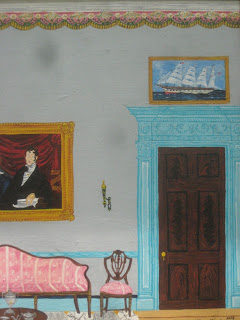The Baltimore home of Shipbuilder John Joseph Despeaux by Andrew LaMar
Hopkins
Sometimes a actual period painting inspires me to paint one of my
Historical Folk art paintings. This is the case with "The Baltimore home of
Shipbuilder John Joseph Despeaux ". The 1820's double portrait in the middle of my
painting is a copy of a period portrait now housed in the Maryland Historical
Society. It is one of my favorite painting there. The architecture of the room
in this painting dates from around 1790 Federal period in America, although the
scene is 1820's.
The door frame and chair rail molding are copied from documented work
from the Edwards brothers, skilled carpenters working in Baltimore during the
late 18th century early 19th century. Ribbon swags are used on either side of
the central motif composed of a bird and formal scrolls on the door cap or
frieze of the entablature of the pastel soft blue painted door frame.
The plaster walls are painted gray. The paneled door
is grained to look like rich flamed Cuban Mahogany. A classical hand blocked
French paper border in Ribbon & swag motif completes the architectural
details of the room. Tacked to the wood floors is a Trompe-l'œil Painted
floorcloth or oil cloth painted to look like tiled marble floor.
A stylish gentleman takes coffee seated at a Baltimore Federal Mahogany
dropleaf tea table with bellflowers inlay on legs. He is seated on
a Philadelphia painted side chair ca. 1808 Designed by Benjamin Henry Latrobe.
French immigrant John Despeaux 1794-1826 and his son John Joseph Despeaux 1817-
1865 circa 1825.
The Classical gold leafed framed portrait in the center of the room is of
French immigrant John Despeaux 1794-1826 and his son John Joseph Despeaux 1817-
1865 circa 1825. Shipbuilder Joseph emigrated to Fells Pont from Haiti in 1793
escaping the slave Revolution. On ether side of the portrait is a pair of French
Empire Argand-type sconces in the form of a caryatid of Japanned & gilt
toleware, Paris 1820. The painting over the door in the French manner of a
Baltimore clipper ship.
French immigrant John Despeaux 1794-1826 and his son John Joseph Despeaux 1817-
1865 circa 1825.
A Pair of Hong China Trade portraits of Mandarin merchants in gold gilt molding
frames, in a early Federal interior shows exotic trade between Baltimore and
china as well as the Chinese Export Canton china ginger jar on the Baltimore
made King of Prussia top corner table by Hugh & John Finlay ca, 1800.
Anything that was Chinese Export displayed in a home in the young nation was
considered to be the pinnacle of taste and sophistication during this period.
The bust on the Royal Sienna marble pedestal is if Francois-Marie Arouet de
Voltaire 1694-1778 school of Jean-Antoine Houdon circa 1795-1801. On the
Maryland Drum table a Circa 1790 Sheffield plate Argand lamp with central urn
sits.
A stylish gentleman takes coffee seated at a Baltimore Federal Mahogany
dropleaf tea table with bellflowers inlay on legs. He is seated on
a Philadelphia painted side chair ca. 1808 Designed by Benjamin Henry Latrobe.
Silver coffee set by Anthony Rasch & Company of Philadelphia. English Adams style silver
hot water urn and Empire Old Paris porcelain coffee can. Other furnishings are Baltimore Easy chair ca. 1816 covered in polished red leather. Baltimore Federal Mahogany Cabriole sofa with bellflowers inlay on legs ca 1800. Baltimore
Mahogany Shield-shaped side chair after Thomas Sheraton ca. 1800. Painting is Acrylic on Canvas 14x18 unframed.
A stylish gentleman takes coffee seated at a Baltimore Federal Mahogany
dropleaf tea table with bellflowers inlay on legs. He is seated on
a Philadelphia painted side chair ca. 1808 Designed by Benjamin Henry Latrobe.
A classical hand blocked French paper border in Ribbon & swag motif
completes the architectural details of the room.
The door frame and chair rail are copied from documented work from the Edwards
brothers, skilled carpenters working in Baltimore during the late 18th century
early 19th century. Ribbon swags are used on either side of the central motif
composed of a bird and formal scrolls on the door cap or frieze of the
entablature of the soft blue painted door frame. The paneled door is grained to
look like rich flamed Cuban Mahogany.










No comments:
Post a Comment